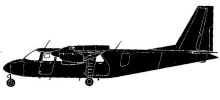
ASN Wikibase Occurrence # 327387
| Date: | Thursday 2 August 1984 |
| Time: | 08:05 |
| Type: |  Britten-Norman BN-2A Islander |
| Owner/operator: | Vieques Air Link |
| Registration: | N589SA |
| MSN: | 38 |
| Year of manufacture: | 1968 |
| Engine model: | Lycoming O-540-E4C5 |
| Fatalities: | Fatalities: 9 / Occupants: 9 |
| Aircraft damage: | Destroyed, written off |
| Category: | Accident |
| Location: | 0,8 km off Vieques Airport (VQS) -
 Puerto Rico Puerto Rico
|
| Phase: | Initial climb |
| Nature: | Passenger - Scheduled |
| Departure airport: | Vieques Airport (VQS/TJCG) |
| Saint Croix-Alexander Hamilton Airport (STX/TISX) | |
| Investigating agency: | NTSB |
| Confidence Rating: |
The Islander was overloaded by 600-700 pounds when it departed Vieques. Also, its centre of gravity was up to 5 inches behind the aft limit. After takeoff the left engine lost power. It lost altitude, banked abruptly to the left, nosed down and crashed into the ocean. It appeared that the fuel had been contaminated with water.
The pilot was not certificated to fly as pilot-in-command of a commuter air carrier flight. The two previous flights flown by the pilot and the accident flight were scheduled flights, operated with a different flight number as "on-demand" flights, for which the pilot was certified.
PROBABLE CAUSE: "The failure of the pilot to execute the emergency engine-out procedure properly shortly after takeoff following a loss of power in the left engine because of water in the airplane's fuel system and the failure of the Puerto Rico Ports Authority to remove excess water known to be in the airport's in-ground fuel tank before conducting fueling operations. The pilot's failure to execute the engine-out procedure properly was due to his inexperience in multi-engine airplanes.
Contributing to the accident were: (1) the air carrier's use of a pilot not certificated for the flight; (2) the air carrier's failure to train the pilot adequately; (3) the pilot's failure to follow proper practices to detect water in the airplane's fuel tanks; (4) the out
of weight and balance condition of the airplane; (5) the Federal Aviation Administration's (FAA) incorrect application of 14 CFR Part 135 Rules to commuter air carriers; and (6) the FAA's generally inadequate surveillance of the air carrier."
Accident investigation:
 |
|
Sources:
NTSB
Revision history:
| Date/time | Contributor | Updates |
|---|
The Aviation Safety Network is an exclusive service provided by:


 ©2024 Flight Safety Foundation
©2024 Flight Safety Foundation